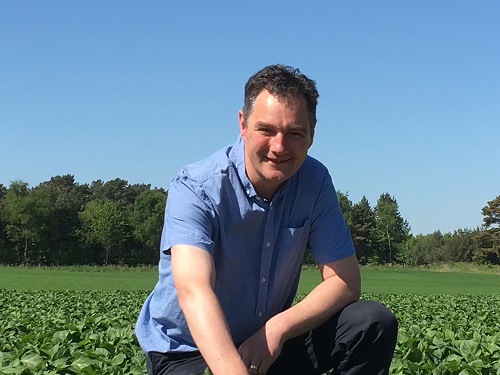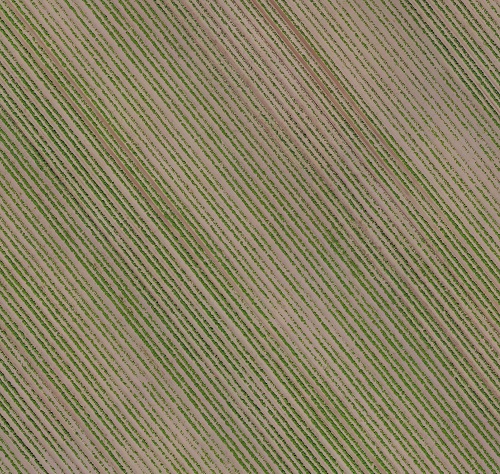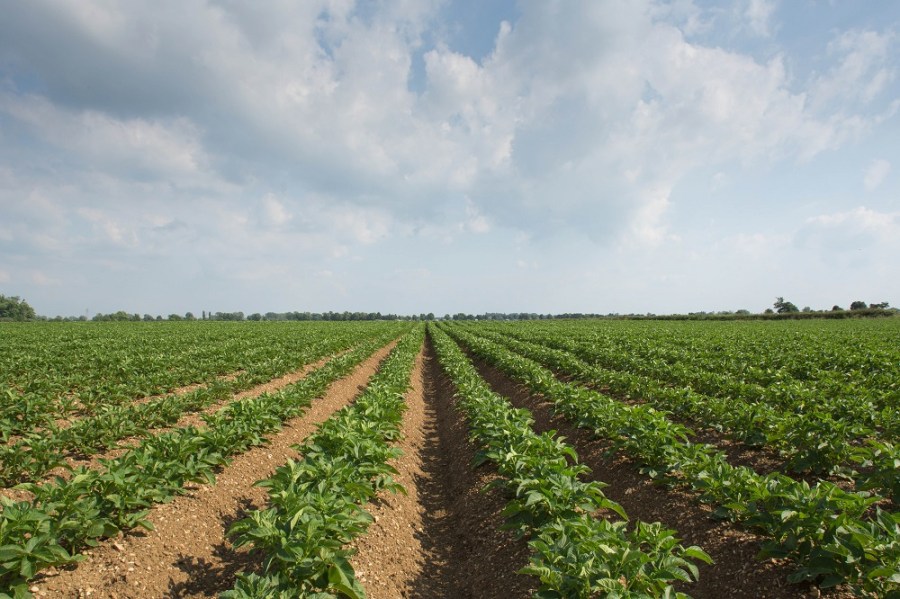Spotting problems in potato fields often happens late in the day. CPM learns how using an eye-in-the-sky is being used to improve crop monitoring and performance.
Our role as agronomists will change.
By Rob Jones
Diseased potatoes are fickle. It’s not uncommon for small areas of infection to remain hidden until late into the growing season or, worse still, when in cold stores.
Sprayer operators are the vigilant eyes that usually spot problems early on, but at speeds upward of 7km/hr, the need to focus on checks like nozzle shut off, manoeuvring at field boundaries and tank reserves, means even the best can miss the small signs.

Andy Steven says that even the best potato agronomists can’t physically get round all their crops when disease pressure is high
There are also limitations for even the best potato agronomists; the time pressures on them are immense, particularly this year following the high rainfall and humidity over recent weeks. Very rapidly, the benign, easy-planting start to the season has morphed into an incredibly high blight-risk period for most, at a very bad time in the growing season, according to Agrovista’s potato specialist, Andy Steven.
“Every agronomist has a huge area of ground to cover and we are now in a high-pressure situation,” he says.
Persistent rainfall
“In Morayshire in early June, we had 105mm of rain in just four days. It was so intense that farmers lost part of their fields. The persistence of the rainfall also prevented early blight sprays from being applied when they were needed,” he says.
Beyond blight, there are other diseases that need sharp spotters. One of these is rhizoctonia, which is well-known to cause black scurf following desiccation.
“The disease stresses the plant and when it’s really bad, the roots will contract, stolons drop off and you’ll lose tuber numbers,” he explains.
“The way the fungus works is that it lays resting spores on the tuber in Aug, which when the crop is desiccated, creates the tell-tale black scurf that makes the potatoes ‘rejects’ when they’re washed in the pack house.”
Over the course of this and previous seasons, Andy Steven and his colleague, Lewis McKerrow, Agrovista’s head of precision services, have been flying their fleet of drones over a large area of potatoes. The sites range in soil type, variety and market destination but their aim has been to capture detailed, birds-eye maps of growing crops for R&D purposes, as well as to support the in-field agronomy.
“Using a drone in any season provides useful information for us as agronomists, but this season, they will be a really valuable agronomy tool,” he says.
“To walk a 10-15ha field for a full assessment of the crop’s health takes a good 1-2 hours, and at a walking man’s eye-level height of 2m, there’s a limit to what can be seen as the canopy develops.

A drone map gives the all-important whole-field view and the resolution is so good that the agronomists can zoom in to individual plant-level detail.
“The other limitation, in contrast to a field of cereals, is that a potato crop can only be walked up and down the rows, rather than being criss-crossed. So what you see may not be representative of the whole field, nor of specific problem areas.”
And this is where a drone map comes in useful. It gives the all-important whole-field view and the resolution is so good on the cameras Agrovista uses, that the agronomists can zoom in to individual plant-level detail.
“In the maps we’ve generated, we’ve picked up stunted areas of growth – the early indicator of rhizoctonia – and other signs of stress,” adds Andy Steven.
“This information can be particularly beneficial in spotting problems like PCN or rhizoctonia early, as well as for logging fields with problems that we need to be aware of before growing another potato crop.”
The drone maps also provide very accurate plant counts, which are useful for a number of reasons. “It’s very likely that a grower will have a plant count plan from the outset, but these can be up to 10% out because of inaccuracies such as the setting of the planter and small errors in planting.
Earlier desiccation
“Getting counts wrong has an impact. With seed crops, if plants are too far apart, the crop desiccation date may need to be earlier than planned to ensure the correct maximum tuber size. For a ware crop, if plants are too close together, the tubers may never reach the size specifications they need to be, whilst if too thinly planted, they get to size quicker than you may have anticipated.”
To any business, this kind of data accuracy also helps with supply chain management, particularly where retailer contracts and supply dates need to be met.
“It’s currently difficult to put a value on this information, but processors are looking at the technology to better understand growers’ crops, which has both positive and negative ramifications for supply chain relationships,” he suggests.
“One thing’s certain, the more market data there is openly available, the more it will influence market prices, as we already see in the futures markets for arable commodities.”
Plant counts can also be valuable information for seed inspectors. For example, if counts are 10% higher than planned, there will be more flexibility in levels of disease permitted in a seed crop.
Another area that Agrovista is advancing is the opportunity for variable rate and targeted application of all inputs, highlights Andy Steven.
“With nutrients and seed, we already have the variable application technology to use the information from drone maps. As far as spraying is concerned, we aren’t there yet,” he says.
“We’re now able to spot-spray specific problems in vegetable crops, but vari-spraying isn’t yet a reality in broad-acre crops like potatoes and cereals. We aren’t a long way off though, and when it comes, it will be invaluable for potato growers.”
Both drone mapping and vari-spraying are unlikely to be of value in managing blight, because it’s very fast and very visual in the crop. But for weed control and targeting hand-roguers to problem zones in the crop, there are huge gains to be made, he adds.
“From what we’ve seen in our drone mapping so far, a single flight can show up stress levels as low as 0.5% of the field area. If this stress is from a disease like black leg, where there’s no chemical control, rogueing is the only option.
“The drone will show a grower exactly where the roguers should work, minimising the time and cost of employing them. But importantly also pinpointing exactly where the infected plants are, thereby reducing the risk of bacterial spread resulting from walking through wide areas of the standing crop to find infected plants,” comments Andy Steven.
Mapping every field
The value of the data gathered over multiple fields and seasons can’t be underestimated, he believes. For a big grower, mapping every field in production can build a picture by field, by variety and by season over time, all of which can be used to make strategic planning decisions across many areas of the business – such as labour needs, machinery and variety choice.
Looking to the future, Andy Steven foresees the drone market for agriculture being ‘massive’.
“Drones won’t do everything and aren’t a replacement for good agronomy, but I envisage that in five years’ time, all young farmers will get a drone for Christmas and will be mapping their own crops. They’ll still need an agronomist to work with them to interpret and act on the findings, but our role as agronomists will change.
“Using technology, like drones, is all about doing things smarter, something that farmers have always been good at.”
Interest in maleic hydrazide grows
Foliar-applied maleic hydrazide (Fazor) could prove a valuable addition for farmers and agronomists to improve the quality of their marketable crop, claims Don Prendergast, product development and technical manager at Arysta LifeScience.
“For the industry to provide a year-long supply of key crops such as potatoes and onions, the control of sprouting is essential. Tubers for crisping and chipping need to be stored at a higher temperature to minimise the conversion of starch to sugars, which adversely affects the fry colour. Of course, this means they are more susceptible to sprouting.
“Unlike other sprout suppressants, maleic hydrazide is different in that it’s applied to the crop whilst it’s in the field, not in storage. Used in addition to other products, it can help growers to extend the sprout-free storage period.”
Following a reduction in total dose rate of widely-used sprout-suppressant, chlorpropham (CIPC), growers are seeking alternative products. With correct application, maleic hydrazide provides sprout suppression in potatoes for up to four months and often beyond, whilst also offering several other key benefits including volunteer control.
“But it isn’t just for suppressing sprouting when the tubers are in storage. Fazor’s highly successful in reducing the number of volunteer potatoes, which become a problematic weed for a wide range of crops,” adds Don Prendergast.
“The active ingredient, maleic hydrazide, is translocated down to the tubers, inhibiting cell division, making it an ideal tool for volunteer control and limiting secondary growths.”
New liquid maleic hydrazide available
A new, liquid formulation of maleic hydrazide has just gained CRD approval for use in potatoes this season. Itcan SL 270 (MAPP 17957) is being marketed in the UK by Gemini Ag for approval holder, Kreglinger Europe NV.
Itcan should be used at a maximum rate of 11.1 l/ha, which delivers 2997g of maleic hydrazide, equivalent to Fazor at 5kg/ha.
James Kennedy, commercial director of Gemini Ag, believes a liquid formulation will be welcomed by spray operators.
“Itcan is an easy to use liquid formulation with comparable efficacy to market alternatives. It has an established track record in Europe and is proving popular, gaining an increasing market share.”
The new product is available in 15 or 200-litre drums and 600 or 1000-litre IBCs. “IBCs are delivered with a pump and flow meter to allow easy and accurate dosing, while reducing operator exposure,” says James Kennedy, adding that IBCs have the added benefit of reducing waste disposal issues.




